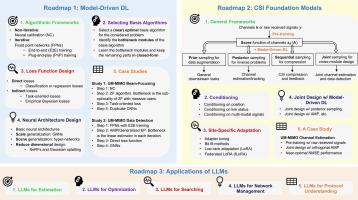太赫兹超大规模MIMO的人工智能和深度学习:从模型驱动的方法到基础模型
IF 11.6
1区 工程技术
Q1 ENGINEERING, MULTIDISCIPLINARY
引用次数: 0
摘要
本研究探讨了人工智能(AI)在解决太赫兹超大规模多输入多输出(UM-MIMO)系统带来的挑战方面的变革潜力。本文首先概述了太赫兹UM-MIMO系统的特点,并确定了收发器设计的三个主要挑战:计算复杂性、建模难度和测量限制。该研究认为,人工智能为这些挑战提供了一个有希望的解决方案。为开发适合太赫兹UM-MIMO系统的人工智能算法,提出了三个系统的研究路线图。第一个路线图,模型驱动深度学习(DL),强调利用可用领域知识的重要性,并主张采用人工智能仅用于增强既定信号处理或优化框架内的瓶颈模块。讨论了四个基本步骤:算法框架、基算法、损失函数设计和神经结构设计。第二个路线图给出了信道状态信息(CSI)基础模型,旨在通过关注它们的共享基础(即无线信道)来统一不同收发器模块的设计。提出了训练单个紧凑基础模型来估计无线信道分数函数的方法,为设计各种收发模块提供了一个通用的前提。概述了四个基本步骤:一般框架、条件调节、特定场地的适应、CSI基础模型的联合设计和模型驱动的深度学习。第三个路线图旨在探索将预训练大语言模型(llm)应用于太赫兹UM-MIMO系统的潜在方向。设想了几个应用场景,包括基于llm的估计、优化、搜索、网络管理和协议理解。最后,指出了研究中存在的问题和未来的研究方向。本文章由计算机程序翻译,如有差异,请以英文原文为准。

AI and Deep Learning for Terahertz Ultra-Massive MIMO: From Model-Driven Approaches to Foundation Models
This study explored the transformative potential of artificial intelligence (AI) in addressing the challenges posed by terahertz ultra-massive multiple-input multiple-output (UM-MIMO) systems. It begins by outlining the characteristics of terahertz UM-MIMO systems and identifies three primary challenges for transceiver design: computational complexity, modeling difficulty, and measurement limitations. The study posits that AI provides a promising solution to these challenges. Three systematic research roadmaps are proposed for developing AI algorithms tailored to terahertz UM-MIMO systems. The first roadmap, model-driven deep learning (DL), emphasizes the importance of leveraging available domain knowledge and advocates the adoption of AI only to enhance bottleneck modules within an established signal processing or optimization framework. Four essential steps are discussed: algorithmic frameworks, basis algorithms, loss-function design, and neural architecture design. The second roadmap presents channel state information (CSI) foundation models, aimed at unifying the design of different transceiver modules by focusing on their shared foundation, that is, the wireless channel. The training of a single compact foundation model is proposed to estimate the score function of wireless channels, which serve as a versatile prior for designing a wide variety of transceiver modules. Four essential steps are outlined: general frameworks, conditioning, site-specific adaptation, joint design of CSI foundation models, and model-driven DL. The third roadmap aims to explore potential directions for applying pretrained large language models (LLMs) to terahertz UM-MIMO systems. Several application scenarios are envisioned, including LLM-based estimation, optimization, search, network management, and protocol understanding. Finally, the study highlights open problems and future research directions.
求助全文
通过发布文献求助,成功后即可免费获取论文全文。
去求助
来源期刊

Engineering
Environmental Science-Environmental Engineering
自引率
1.60%
发文量
335
审稿时长
35 days
期刊介绍:
Engineering, an international open-access journal initiated by the Chinese Academy of Engineering (CAE) in 2015, serves as a distinguished platform for disseminating cutting-edge advancements in engineering R&D, sharing major research outputs, and highlighting key achievements worldwide. The journal's objectives encompass reporting progress in engineering science, fostering discussions on hot topics, addressing areas of interest, challenges, and prospects in engineering development, while considering human and environmental well-being and ethics in engineering. It aims to inspire breakthroughs and innovations with profound economic and social significance, propelling them to advanced international standards and transforming them into a new productive force. Ultimately, this endeavor seeks to bring about positive changes globally, benefit humanity, and shape a new future.
 求助内容:
求助内容: 应助结果提醒方式:
应助结果提醒方式:


